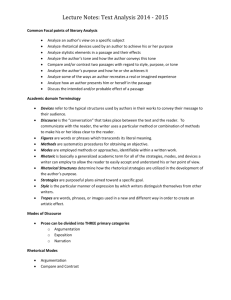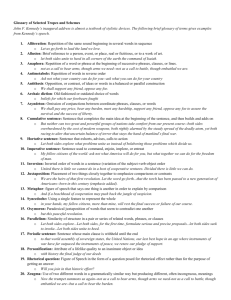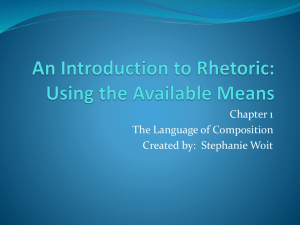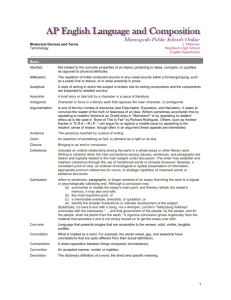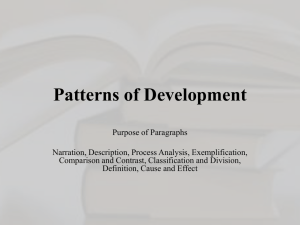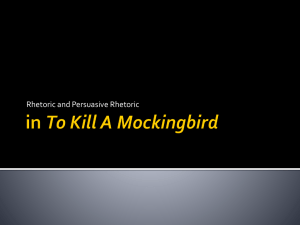The Personal Narrative Essay
advertisement
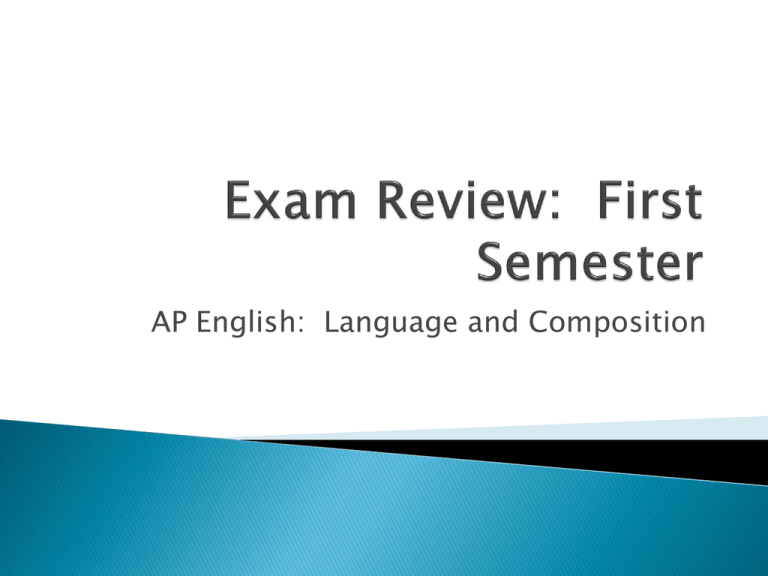
AP English: Language and Composition A personal narrative is an essay about an incident in your life. 1. 2. 3. It tells about an important event in your life. It describes details that were part of the experience to bring the experience to life for your audience (readers). It explains the importance of the event. Rhetoric is a thoughtful, reflective activity leading effective communication, including rational exchange of opposing viewpoints. Aristotle defined rhetoric as “the faculty of observing in any given case the available means of persuasion.” Rhetoric is always situational. Persona is the character a writer or speaker creates to deliver a piece. Ethos is character. A speaker or writer must establish his or her own credibility or trustworthiness. Pathos is the use of emotion. Logos is reason. Narration Narration refers to telling a story or recounting a series of events. Narrative essays are based on personal experience or knowledge gained from reading or observation. Narration usually relies on chronological order. Narration Narration includes concrete detail, point of view and, sometimes, dialogue. Narration is more than telling a story; it is crafting a story that supports a thesis. Description Description relies on specific details. Description emphasizes the senses by painting a picture of how something looks, sounds, smells, tastes or feels. Most often, description is part of other forms of essay—clear and vivid description can make writing more persuasive by asking the reader to empathize with the writer, the subject or the argument. Process Analysis Process analysis explains how something works, how to do something or how something was done., The key to successful process analysis is clarity; it is important to explain the subject clearly and logically, with transitions that mark the sequence of major steps, stages or phases of the process. Exemplification Providing a series of examples—facts, specific cases or instances—turns a general idea into a concrete one, which makes an argument more clear and persuasive. Induction—a type of logical proof in which a writer gives a series of specific examples that leads to a general conclusion. Comparison and Contrast Comparison and contrast juxtaposes two different things to highlight their similarities and differences. Comparison and contrast is used to analyze information carefully and reveals insights into the nature of the information being analyzed. Comparison and Contrast Comparison and contrast can be organized in two main ways: subject by subject or point by point. ◦ Subject by subject analysis discusses all the elements of one subject and then moves on to the other. ◦ Point by point is organized around specific points of a discussion, showing the points of similarity and difference between an aspect of the two main subjects before moving to the next aspect. Classification and Division Classification sorts material or ideas into major categories. Classification explains what goes together and gives the reason/s for the grouping. Classification can make connections between things that might otherwise seem unrelated. Classification and Division Division gives distinctive ways of breaking a large idea or concept into parts. The writer explains the reasoning behind each division with examples and analysis. Definition Definition is an essential part of most essays. It explains what a term means specifically so that the writer and audience are speaking the same language. Definition may lay the foundation to establish common ground or identify areas of conflict. Definition Definition is often the first step in a debate or disagreement. In some cases, definition is only a paragraph or two used to clarify terms. In other cases, the purpose of an entire essay is to establish a definition. Cause and Effect Cause and effect essays analyze the causes that lead to a certain effect or the effects that result from a cause. Causal analysis relies on crystal clear logic, carefully tracing a chain of cause and effect to recognize contributing causes. Cause and effect essays are often signaled by the use of the word why in the title or first paragraph. 1. Which of the important words in the passage (verbs, nouns, adjectives, and adverbs) are general and abstract? Which are specific and concrete? 2. Are the important words formal, informal, colloquial, or slang? 3. Are some words nonliteral or figurative, creating figures of speech such as metaphors? 1. 2. What is the order of the parts of the sentence? Is it the usual order (subjectverb-object) or is it inverted? Which part of speech is more prominent— nouns or verbs? 3. 4. What are the sentences like? Are they periodic (moving toward something important at the end) or cumulative (adding details that support an important idea in the beginning of the sentence)? How does the sentence connect its words, phrases, and clauses? Alliteration—repetition of the same sound at the beginning of words Allusion—reference to a person, event or place (real or fictitious) or to a work of art Anaphora—repetition of a word or phrase at the beginning of successive phrases, clauses or lines Antimetabole—repetition of words in reverse order Antithesis—opposition or contrast, of ideas or words in parallel construction Archaic diction—old-fashioned or outdated choice of words Asyndeton—omission of conjunctions between coordinate phrases, clauses or words Cumulative sentence—completes the main idea of the sentence at the beginning and adds onto the idea Hortative sentence—sentence that exhorts, urges, entreats or calls to action Imperative sentence—sentence that commands Inversion—inverted order of words in a sentence Juxtaposition—placement of two things closely together to emphasize similarities or differences Metaphor—figure of speech that says that one thing is another thing Oxymoron—paradoxical juxtaposition of words that seem to contradict one another Parallelism—similarity of structure in a pair of sentences or series of related words, phrases, or clauses Periodic sentence—sentence with its main clause held until the end of the sentence Personification—attribution of human qualities to an inanimate object or idea Rhetorical question—figure of speech in the form of a question that is asked for rhetorical effect rather for the purpose of getting an answer Synecdoche—uses a part to represent the whole Zeugma—use of two different words in a grammatically similar way that produces different, often incongruous, meanings
